Have you ever craved the rich, nutty flavors of traditional Filipino Kare-Kare but worried about the carb content? Well, worry no more! Today, I’m excited to share with you a keto-friendly version of this beloved dish that will satisfy your cravings without derailing your low-carb lifestyle.
Kare-Kare is a hearty stew that typically combines tender oxtail, tripe, and vegetables in a thick, peanut-based sauce. It’s a staple in Filipino cuisine, often served at special occasions and family gatherings. The dish is known for its complex flavors, creamy texture, and comforting warmth. However, the traditional recipe can be high in carbohydrates due to ingredients like rice flour and certain vegetables.
Our Keto Kare-Kare recipe maintains the essence of this classic dish while adapting it to fit a low-carb, high-fat diet. We’ve carefully selected ingredients that capture the authentic taste and texture of Kare-Kare without the excess carbs. This version is perfect for those following a ketogenic diet, but it’s also a delicious option for anyone looking to reduce their carb intake or try a new twist on a Filipino favorite.
In this blog post, we’ll walk you through the step-by-step process of creating this keto-friendly Kare-Kare. We’ll cover everything from ingredient selection to cooking techniques, ensuring you can recreate this dish in your own kitchen with confidence. Whether you’re a seasoned keto cook or new to low-carb eating, this recipe is designed to be accessible and enjoyable for all skill levels.
So, let’s dive in and discover how to make this creamy, flavorful Keto Kare-Kare that will transport your taste buds to the Philippines without breaking your carb bank!
Recipe Ingredients
Before we start cooking, let’s gather all the ingredients we’ll need for our Keto Kare-Kare. This recipe serves 6 people.
| Ingredient | Quantity |
|---|---|
| Oxtail | 2 lbs |
| Beef tripe (cleaned and pre-boiled) | 1 lb |
| Unsweetened almond milk | 2 cups |
| Natural peanut butter (no added sugar) | 1/2 cup |
| Coconut aminos | 2 tablespoons |
| Fish sauce | 1 tablespoon |
| Garlic cloves (minced) | 4 |
| Onion (chopped) | 1 medium |
| Ginger (minced) | 1 tablespoon |
| Beef bone broth | 4 cups |
| Xanthan gum | 1 teaspoon |
| Olive oil | 2 tablespoons |
| Salt | To taste |
| Black pepper | To taste |
| Bok choy | 2 cups, chopped |
| Green beans | 1 cup, cut into 2-inch pieces |
| Eggplant | 1 medium, sliced |
| Annatto powder (for color) | 1 teaspoon |
Ingredient Substitutions:
- If you can’t find oxtail, you can use beef shank or short ribs.
- For a vegetarian version, replace the meat with firm tofu and use vegetable broth instead of beef bone broth.
- If annatto powder is unavailable, you can use a small amount of paprika for color.
Recipe Instructions
Now that we have all our ingredients ready, let’s start cooking our Keto Kare-Kare. Follow these steps carefully for the best results:
- Prepare the meat:
- Season the oxtail and tripe with salt and pepper.
- In a large pot or pressure cooker, heat 1 tablespoon of olive oil over medium-high heat.
- Brown the oxtail and tripe in batches, about 3-4 minutes per side. Set aside.
- Create the base:
- In the same pot, add the remaining olive oil.
- Sauté the minced garlic, chopped onion, and ginger until fragrant and the onions are translucent (about 3-4 minutes).
- Add the browned meat back to the pot.
- Pour in the beef bone broth and bring to a boil.
- Reduce heat, cover, and simmer for 2-3 hours or until the meat is tender. If using a pressure cooker, cook for about 45 minutes to 1 hour.
- Prepare the sauce:
- In a separate bowl, whisk together the almond milk, peanut butter, coconut aminos, fish sauce, and annatto powder until smooth.
- Slowly pour this mixture into the pot with the tender meat, stirring constantly to incorporate.
- Simmer for another 15-20 minutes, allowing the flavors to meld.
- Thicken the stew:
- Sprinkle the xanthan gum over the surface of the stew, whisking vigorously to prevent clumps.
- Continue to simmer and stir until the sauce thickens to your desired consistency.
- Cook the vegetables:
- Add the green beans and eggplant to the pot. Cook for about 5 minutes.
- Finally, add the bok choy and cook for an additional 2-3 minutes until just wilted.
- Adjust seasoning:
- Taste the Kare-Kare and adjust the seasoning with salt and pepper as needed.
- If you prefer a stronger peanut flavor, you can add a bit more peanut butter.
- Serve:
- Ladle the hot Keto Kare-Kare into bowls, ensuring each serving has a good mix of meat, vegetables, and sauce.
Your Keto Kare-Kare is now ready to be enjoyed! The rich, creamy sauce combined with tender meat and crisp vegetables creates a truly satisfying meal that stays true to the original flavors of this Filipino classic.
Recipe Tips & Variations
To make your Keto Kare-Kare experience even better, here are some helpful tips and exciting variations to try:
Tips for Success:
- For the best flavor, make this dish a day ahead. The flavors will deepen overnight in the refrigerator.
- If the sauce becomes too thick after refrigeration, thin it out with a bit of warm beef broth or water when reheating.
- To save time, you can pre-cook the oxtail and tripe in a slow cooker or pressure cooker before starting the recipe.
- For a smoother sauce, blend the peanut butter mixture before adding it to the pot.
Variations:
- Seafood Keto Kare-Kare: Replace the oxtail and tripe with a mix of shrimp, squid, and firm white fish. Reduce the cooking time accordingly.
- Spicy Keto Kare-Kare: Add 1-2 chopped bird’s eye chilies or a teaspoon of chili flakes to the sauce for a spicy kick.
- Vegetable-Heavy Kare-Kare: Increase the vegetable content by adding low-carb options like cauliflower florets or sliced radishes.
- Pork Keto Kare-Kare: Use pork belly instead of oxtail for a different but equally delicious version.
Storage Instructions:
Store leftover Keto Kare-Kare in an airtight container in the refrigerator for up to 3 days. The flavors often improve with time, making it an excellent make-ahead meal. When reheating, do so gently over low heat, stirring occasionally and adding a splash of broth if needed to maintain the desired consistency.
Nutritional Information
Understanding the nutritional content of our Keto Kare-Kare is important, especially for those closely monitoring their macronutrient intake. Here’s an approximate breakdown per serving (based on 6 servings):
| Nutrient | Amount per Serving |
|---|---|
| Calories | 450 |
| Total Fat | 35g |
| Saturated Fat | 10g |
| Cholesterol | 85mg |
| Sodium | 580mg |
| Total Carbohydrates | 8g |
| Dietary Fiber | 3g |
| Net Carbs | 5g |
| Protein | 28g |
Please note that these values may vary slightly depending on the specific brands of ingredients used and any substitutions made.
As we come to the end of our Keto Kare-Kare journey, I can’t help but reflect on the joy of creating a low-carb version of this beloved Filipino dish. The rich, creamy peanut sauce, tender meat, and crisp vegetables come together to create a truly satisfying meal that honors the original while catering to a ketogenic lifestyle.
I remember the first time I tasted traditional Kare-Kare at a family gathering in Manila. The complex flavors and comforting warmth of the dish left a lasting impression. When I embarked on a keto diet, I thought I’d have to say goodbye to many of my favorite Filipino dishes. But with some creativity and experimentation, I’ve found that it’s possible to enjoy the essence of these cultural classics while staying true to my health goals.
Now, I invite you to try this Keto Kare-Kare recipe in your own kitchen. Whether you’re following a strict keto diet or simply looking to reduce your carb intake, this dish is sure to impress. Don’t be intimidated by the list of ingredients or the cooking time – the process is straightforward, and the result is well worth the effort.
As you savor each spoonful of this Keto Kare-Kare, I hope it brings you the same comfort and satisfaction that the traditional version does. And who knows? You might even prefer this low-carb adaptation!
I’d love to hear about your experience making and tasting this Keto Kare-Kare. Did you try any of the variations? How did it compare to the traditional version for you? Share your thoughts, photos, and any tweaks you made to the recipe in the comments below or on our social media channels.
If you enjoyed this keto-friendly take on a Filipino classic, be sure to check out our other low-carb adaptations of international cuisines. From Keto Chicken Adobo to Low-Carb Pancit, we’re always exploring ways to make beloved dishes accessible to those following a ketogenic lifestyle.
Thank you for joining me on this culinary adventure. Here’s to enjoying the flavors we love while nourishing our bodies in the way that suits us best. Happy cooking, and kain na tayo! (Let’s eat!)
Disclaimer: This recipe is intended for informational purposes only and is not meant to provide medical or nutritional advice. While we strive for accuracy, nutritional information may vary based on specific ingredients and brands used. If you have any health concerns or specific dietary requirements, please consult with a healthcare professional or registered dietitian before making significant changes to your diet. If you notice any inaccuracies in the information provided, please report them so we can correct them promptly.




